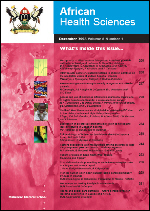
|
African Health Sciences
Makerere University Medical School
ISSN: 1680-6905
EISSN: 1680-6905
Vol. 15, No. 3, 2015, pp. 797-802
|
 Bioline Code: hs15110
Bioline Code: hs15110
Full paper language: English
Document type: Research Article
Document available free of charge
|
|
|
African Health Sciences, Vol. 15, No. 3, 2015, pp. 797-802
| en |
Evaluating the use of cell phone messaging for community Ebola syndromic surveillance in high risked settings in Southern Sierra Leone
Kangbai, Jia & Koroma, Mohamed
Abstract
Background: Most underdeveloped countries do not meet core disease outbreak surveillance because of the lack of human
resources, laboratory and infrastructural facilities. The use of cell phone technology for disease outbreak syndromic surveillance
is a new phenomenon in Sierra Leone despite its successes in other developing countries like Sri Lanka. In this study
we set to evaluate the effectiveness of using cell phone technology for Ebola hemorrhagic fever syndromic surveillance in a
high risked community in Sierra Leone.
Objectives: This study evaluated the effectiveness of using cell phone messaging (text and calls) for community Ebola
hemorrhagic fever syndromic surveillance in high risked community in southern Sierra Leone.
Method: All cell phone syndromic surveillance data used for this study was reported as cell phone alert messages-texts and
voice calls; by the Moyamba District Health Management Team for both Ebola hemorrhagic fever suspect and mortalities.
We conducted a longitudinal data analysis of the monthly cumulative confirmed Ebola hemorrhagic fever cases and mortalities
collected by both the traditional sentinel and community cell phone syndromic surveillance from August 2014 to October 2014.
Results: A total of 129 and 49 Ebola hemorrhagic fever suspect and confirmed cases respectively were recorded using the
community Ebola syndromic surveillance cell phone alert system by the Moyamba District Health Management Team in October 2014. The average number of Ebola hemorrhagic fever suspects and confirmed cases for October 2014 were 4.16 (Std.dev 3.76) and 1.58 (Std.dev 1.43) respectively. Thirty-four percent (n=76) of the community Ebola syndromic surveillance cell phone alerts that were followed-up within 24 hours reported Ebola hemorrhagic fever suspect cases while 65.92% (n=147) reported mortality.
Conclusion: Our study suggests some form of underreporting by the traditional sentinel Ebola hemorrhagic fever disease surveillance system in Moyamba District southern Sierra Leone for August-September 2014. Cell phone messaging technology can be effectively use as a tool for community epidemic surveillance from peripheral health care facilities to higher levels.
Keywords
Cell phone, Community, Ebola, Syndromic, Surveillance
|
| |
© Copyright 2015 - African Health Sciences
|
|
